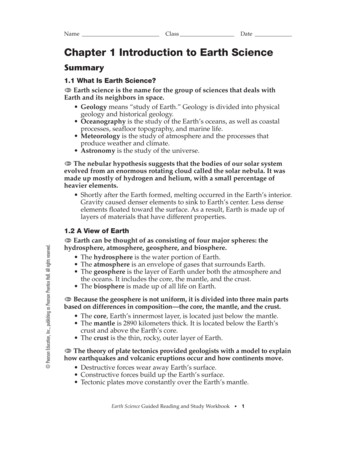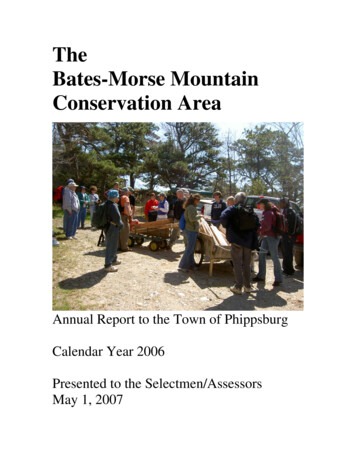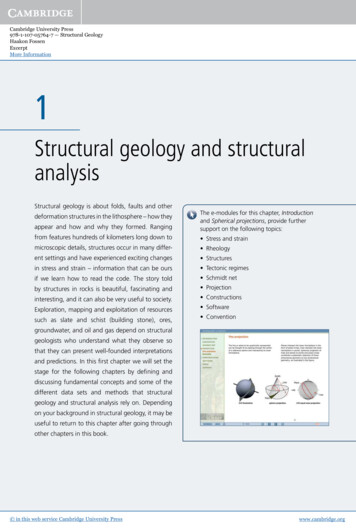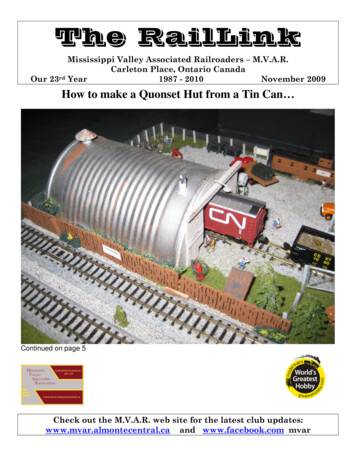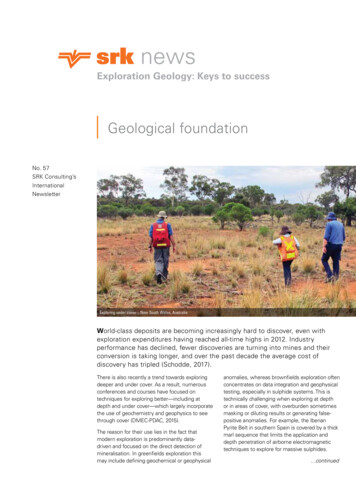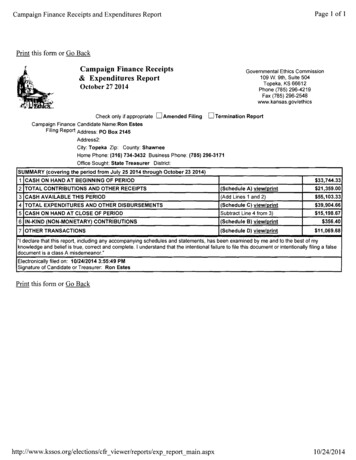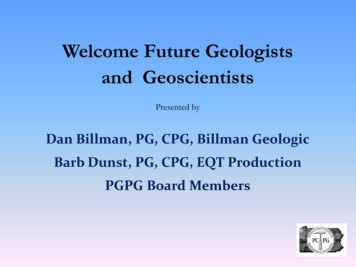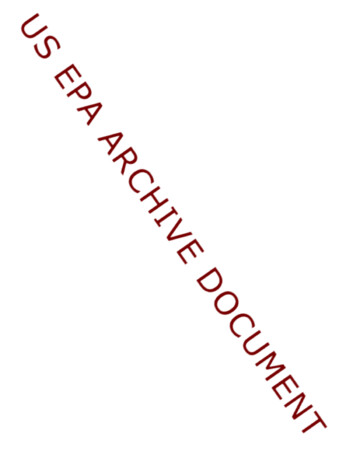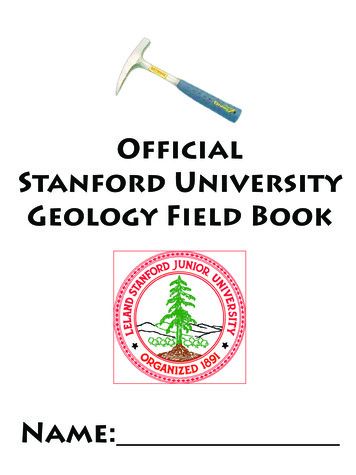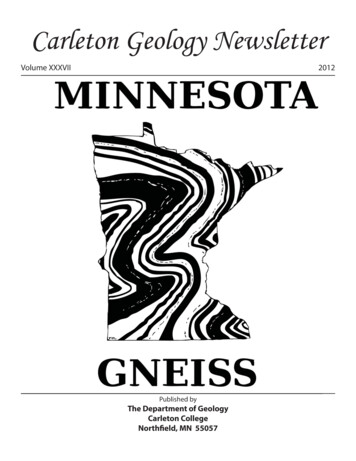
Transcription
Carleton Geology NewsletterVolume XXXVII2012Published byThe Department of GeologyCarleton CollegeNorthfield, MN 55057
The cover drawing is the 2012 Geology T-shirt design by Taylor LaCasse ‘13The Carleton Geology Newsletter is edited by Jonathon CooperLayout by Ellen HaberothPhoto Submissions:Pictures submitted to the Newsletter can be either in traditional print orelectronic formats, but electronic pictures should be medium to high resolutionin order to reproduce well on paper. The file size of electronic pictures should be severalhundred KB or more.If you have a change of address or other correction toour address list you may edit it yourself and make sureyour listing is done the way you prefer athttp://apps.carleton.edu/alumni/directory/If you have forgotten your username or passwordcall the Alumni Affairs Office at 1-800-729-2586.OrYou may notify:Alumni RecordsCarleton CollegeNorthfield, MN 55057(507) 222-4195E-mail: addresses@carleton.edu
Department of GeologyCarleton CollegeOne North College StreetNorthfield, MN 55057June 2012Dear Friends of the Geology Department,On behalf of the Geology Department, I send you greetings, best wishes and another edition of our Carleton GeologyNewsletter. The faculty is busy and productive in their research, teaching and service. You will find detailedaccomplishments of each faculty in the pages that follow. As always, there were many field experiences for studentsand faculty this year. In the fall, we had an over night field trip to Taylors Falls where over 40 students participated. Inthe winter term, our New Zealand off campus program had 21 students participate and our spring field trip to Missouriwas also a great success. Again, a few of our former students won highly competitive National Science FoundationFellowships. Seventeen seniors of the class of 2012 successfully finished their comps and a few of them are off tograduate schools and many have internships and summer jobs waiting for them. Most of the class of 2013 are scattered allover the country to do research for their comps. Twenty-one sophomores (class of 2014) declared geology as their majorand we are delighted to have them for the next two years in the department.We have had lots of good news in 2012. Sarah Titus was awarded tenure, promoted to Associate Professor and received aprestigious CAREER grant from the National Science Foundation for a five-year research project. Congratulations Sarah!We are very fortunate this year to have Nick Swanson-Hysell 05’ and Ellen Schaal 05’ as visiting professors. In the fall,Nick Swanson-Hysell taught Sedimentology and Stratigraphy. Nick completed his Ph. D at Princeton in September 2011and currently, he is a Postdoctoral Fellow at the University of Minnesota. Ellen Schaal, a Ph. D candidate at StanfordUniversity, taught Paleobiology. Both Nick and Ellen did a great job and we wish them success with their futures.Much of our departmental success is due to the extraordinary skills of Jonathon Cooper and Ellen Haberoth. Their talents,and tolerance are evident in these annual reports, which they start putting together in advance. We know that geologydepartments are by their nature cluttered and dusty places, but thanks to John Berg and Kass McKenna, our custodians,who continue to keep labs and classrooms in Mudd Hall a model for cleanliness.We hope that this report finds you well.Sincerely,Bereket Haileab3
DEPARTMENTAL NEWSthe provenance of the CPW terrane. This summer, NickRoberts ’13 will be heading to Alaska with me to continueworking on this project.FACULTY UPDATE - CAM DAVIDSONA return to teaching in the fall was a welcome shock to thesystem after a productive sabbatical year during the 20102011 academic year. I must say it was great to feel like agraduate student again and get lost in research. However,teaching is always a good reality check, and I really enjoyed teaching a Freshman seminar, Geology in the Field(Geo 100), in the fall, Mineralogy with 21 students in thewinter, and I currently have 39 students in two sections ofIntroduction to Geology this spring.In addition to the Keck/NSF project in Alaska thissummer, I’m looking forward our 4th installment of theCarleton Summer Science Institute (CSSI 2012) whichtakes place for in July and August. This summer we willhave a total of six research sections (72 students) coveringvarious topics in geology, neuroscience, chemistry, andanimal behavior. It’s aimed at rising juniors and seniors inhigh school, so if you know anyone looking for a rigorous,but fun summer experience in the sciences, please directthem to our website: http://apps.carleton.edu/summer/science/In my report last year, I mentioned that John Garver(Union College) and I submitted a research proposal toNSF to fund our Alaska research, and we received thegood news late in spring that we were funded for the nextfour years! This means that John and I, and a number ofCarleton and Union students, will be going to Alaska overthe next few years to work on the tectonic and thermal history of the Chugach-Prince William Terrane. (See http://keckgeology.org/node/208 for more information about thissummer’s effort.) As part of the Keck/NSF project thispast summer, Hannah Hilbert-Wolf ’12 worked with me on“A U/Pb detrital zircon provenance study of the flysch ofthe Paleogene Orca Group, Chugach-Prince William Terrane, Alaska” for her Comps. She laid the groundwork bycollecting and processing a heroic number of U/Pb zircondates ( 1500), and made an important contribution onKeck Summer 2011From left to right: Cam Davidson,Ben Carlson (Union College), EmilyJohnson (Whitman College), SarahOlivas (University of Texas-El Paso),Lucy Miner (Macalester College),Hannah Hilbert-Wolf (Carleton),Steve Espinoza (University of Texas-ElPaso), John Garver (Union College).4
DEPA RT M E N TALN E W SFACULTY UPDATE - BEREKET HAILEABLast summer, I went to Northern Kenya to attend the tenth workshop on Human Evolution, which was devoted to the reevaluation of the Geological History of the Turkana Basin. This is the subject that I have been interested in since I cameto the USA and it was a very successful meeting for me. I met many colleagues that I have known for a long time andmany whom I have only heard their names. Upon returning to Carleton, I team taught the Human Evolution and Pre-History course with Nancy Wilkie which was a great success. There were 25 students in the class and I learned a lot and willbe teaching the course in the near future.In the fall, the Geological Society of American annual meeting was in Minneapolis and we took advantage of the vicinityof the meeting and had several students present abstracts on many of subjects that we have been working on.My family and I are doing well. This year was Delina’s first year in the middle school and she did well. She was studentof the month in October, in the A honor rolls and is enjoying school. Amira will be third grade next year and really lovesschool.FACULTY UPDATE - MARY SAVINALast year when I wrote a piece for the newsletter, I anticipated spending the first part of the summer doing field work inthe Cannon River. No one told the rain gods, though, and the river remained high from late May through early August.My student, Tony Daza, collected, keyed and measured mussel shells during one of the periods when the river droppedenough to expose one or two of the lateral bars. Also, he compiled the information that will allow us to document theriver levels from before the September 2010 flood to the present. In the fall, Ailsa McCulloch, a 2012 grad, was able to dosome of the mapping we’d hoped to do during the summer. This summer, my student Kao Sutton and I are again hopingto get into the river – but if we can’t, we have a backup plan to document the changes in channel form over time. I’ve alsobeen involved in conversations to locate a USGS gage in Northfield and to predict the effects of modifying or taking downthe Ames Mill Dam in downtown Northfield (note: there are no immediate plans to do that). This work has involved talking with a couple of groups of St. Olaf students, colleagues at both colleges, and professionals from several city, state andfederal agencies.In August, my cousin Carol and I traveled to Iceland for two weeks. It was fun for me to be on a field trip that I didn’thave to organize! We traveled in a small group – less than 15 – with folks from all over the world. I am planning to takean alumni trip to Iceland, perhaps in summer 2013 (watch for it), so this was especially good preparation for me.Teaching highlights of this academic year included working with a great group of students in Geology of Soils in the fall,and running the first half of the New Zealand OCS program (you can read more about that elsewhere in the newsletter).In New Zealand, both Sarah and I were greatly helped by Nick Riordan, ’07, Zack McGuire, ’08, and Tyler Mackey, also’08 who were our teaching assistants, drivers, logistics managers, sanity preservers, and much more.I’ll be on leave for the entirety of the 2012-13 academic year. Nancy Wilkie and I hope to complete work on thepublication(s?) for the Grevena Project (finally). As part of this effort, I plan to spend the winter in the southern hemisphere again, this time working with Richard Doyle who did his graduate theses in Grevena and who is now in the Soilsdepartment at the University of Tasmania.Mary Savina & Robb Jacobson ‘79 - Missouri Field Trip
DEPA RT M E N TALFACULTY UPDATE - CLINT COWANI have been on sabbatical this Fall & Spring Terms, andduring Winter Term, I used a ‘Targeted Opportunity Grant’from the College to work on identifying and filling gaps inthe College’s fossil collection (mostly in marine invertebrate groups). This was challenging, but included a trip tothe Tucson Mineral and Gem show (which was an amazing experience that I recommend to anyone interested inrocks, minerals, fossils, and gems). We now have a morerobust teaching and learning set of fossils of soft-bodiedthings (Ediacaran and Burgess-Chengjiang-type organisms), small shelly fauna, micro-fossils, and other coolthings like eurypterids, sponges, and some crazy goodgraptolites that were previously sparsely represented in thecollection. Our ability to purchase these important teaching specimens is due solely to the generosity and kindnessof Alums, Friends, and Parents, who over the years havedonated significant funds to the Geology Department tohelp us maintain our teaching collections and equipment.So we thank them profusely for this. These specimens willbe used by generations of Carleton students.I found some time (not enough) to squeeze in someresearch, in particular, I am pursuing two projects: somefield measurements to test a hypothesis about the viscosity of ancient seawater, and working with Julia Anderson(Minnesota Geological Survey) and former student Andrew Walters ’11 (now a the University of WisconsinMadison) on high-resolution isotope stratigraphy in thePlatteville Limestone around southeastern Minnesota andnortheastern Iowa. My sabbatical was rather odd this year,as I spent a great deal of time working on the logisticsfor the Off Campus New Zealand Program for Mary andSarah. To relieve me of some of these duties in the future,Jonathon Cooper and I are going to New Zealand for aN E W Scouple weeks this summer, using funds from the Officeof Off-Campus Studies, for him to learn the ins-and-outsof logistics for future programs. I also did some planningand travelling to create a new Off-Campus Winter Breakprogram in Belize, Central America (for Fall 12-Winter 13), and so I’m all set to take 15 students to the TobaccoCaye Research Station for two weeks next December. Idid research in coastal Belize when I first got to Carleton,but I have never taken this many students before, so I’mlooking forward to the field-teaching experience in thisamazing natural setting. We will study benthic marineflora and fauna, and mangrove, and the controls on theirdistributions. We will also study things like nutrient loading, bleaching, ocean acidification, etc., so this programhas been of interest to Biology and ENTS majors, as wellas to Geo Majors.What is left of my sabbatical ends abruptly this summer, asour 5th Year Allensworth Intern, Zach Stewart ’12, startsworking with Tony Runkel (Minnesota Geological Survey)and I on a project in the Jordan Sandstone that has implications for Cambrian mid-continent events (tsunamis? seismicity? impacts?), and comes in to play for understandingmodern groundwater flow in this unit (it is the aquifer forthe Twin Cities Metropolitan area). Also this summer,rising senior Andrew Wolter ’13 is going to work with meto develop a bone histology module for Paleobiology- thiswill include comparing modern and fossilized bones inthin-section (mostly femurs, which I purchased in Tucsonand online) from things like fossil and modern bison, camels, giraffes, alligators, birds, turtles, etc. He is also goingto assemble a complete ostrich skeleton for display in theWeitz Center, with the help of Jonathon Cooper, who willassist with his “Smithsonian expertise” (making resin castsof the bones, wiring them together . etc.). This should bepretty cool.Dickinsonia MinimaPrecambrian – Vendian542-630 million years oldWhite Sea, Arkangelsk, Siberia
DEPA RT M E N TALN E W Sbreakup with Australia. The students were excellentsports in less than ideal conditions – waking up for 6:30breakfasts without complaint, working through gale-forcewinds, fording cold and rocky rivers, peering at the plateboundary through pouring rain.FACULTY UPDATE - SARAH TITUSThis was a big year for me. I was awarded tenure, whichis a welcome relief. I was also awarded two NSF grants.One funds a project with Joshua Davis, my sweetheart, onmathematical methods for structural geology applications.I’ve been working with sophomore geology major MariahRadue on the field components of this project in Maryland.I may finally be forced to understand Appalachian geology.The second grant is a 5-year CAREER grant to look attransform fault systems in oceanic plates. Eventually itwill involve field work in Cyprus and in Iceland withgeology majors. Plus, I will attempt to recruit physics,math, or computer science students over the next few yearsto help with modeling of field data (with the idea that theseare students who have yet to recognize the geosciences asan option for graduate school). Because CAREER grantsemphasize education, there is also a planned summerprogram for local middle-school girls to get them (or keepthem) interested in science.And for that Geophysics class maybe you guessedthat the colleague from physics is my Dad? It’s true.The 17 students in Geophysics are having a “doubleTitus” experience. I’ve never taught an interdisciplinaryclass before – there is actually a lot of negotiation aboutwhat happens when there are such distinct disciplinarydifferences when approaching the same topics. I’ve learneda lot of basic physics that I probably should have knownbefore.On the teaching front, I had the opportunity to teach twonew courses this year, which hasn’t happened since myfirst year of teaching (when every course was new). Thefirst was part of our off-campus studies program in NewZealand. The second was a Geophysics course with acolleague in the physics department.The OCS program in New Zealand was a welcome changeof pace. Teaching in the field is so different than preparingclasses back in Northfield – you can watch students reallyget concepts that are difficult to illustrate on the board. Wehad two scenic mapping projects – in the mountains andby the ocean – as well as a put-together-the-outcrops-inspace-and-in-time project to tell a story of New Zealand’sStudents in geophysics use a magnetometer to survey theBald spot.Students on the OCS program to New Zealand take a walkon Fox Glacier.7
DEPA RT M E N TALN E W Sas an NSF Earth Science Post-doctoral Fellow. All aroundme here at the U of M Earth Science Department are otherCarls---both Dan Jones ‘06 and Ben Harrison ‘03 areworking as postdocs in Jake Bailey’s geobiology lab justaround the corner.VISITING FACULTY - NICHOLAS SWANSON-HYSELLWhat fun it was to be back in Northfield this fall teachingSedimentology and Stratigraphy. One of the joys inpreparing for the course was to work with Karen Campbell‘79 in August to plan sedimentology experiments at SaintAnthony Falls laboratory where Karen was workingas the director of education for the National Center forEarth-Surface Dynamics. As many of you know, Karensuffered a serious stroke while on vacation in northernMinnesota at the end of August and is currently on a longjourney of recovery . Karen’s enthusiasm to work withme to develop meaningful hands-on experiments forthe class’s day at the lab was invaluable help and reallyspeaks to her love of science and dedication to educationaloutreach.I just returned from a trip up to Thunder Bay Ontariowith Angus Vaughan ‘12 and Kris Asp ‘12 who bothpresented posters related to their comps research on theMidcontinent Rift at the Annual Meeting of the Instituteon Lake Superior Geology. As one could expect at anysuch conference, we bumped into other Carleton Geologymajors including Jake Gibbons ‘07 and George Hudak ‘84.Fieldwork this summer will take me to the Lake Superiorregion, where the work I started last summer with Anguswill continue, and then to Botswana before another Fall,Winter and Spring in Minnesota. Sarah, Maddy and Iare hoping that this next winter brings more snow to theground than the last one. Moving back from New Jerseyto Minnesota we have high hopes of getting out on crosscountry skis.The first week of fall term classes was a busy one forme as I flew back at the end of it to defend my Ph.D. atPrinceton. Thankfully the defense went smoothly and Iwas back in Mudd Hall newly credentialed for the start ofsecond week. The term flew by as we developed bedformsat St. Anthony Falls lab, analyzed large datasets of tidaldata and student-measured foreset thickness in MATLAB,and measured stratigraphic sections up-and-down theHollandale Embayment.VISITING FACULTY - ELLEN SCHAALAs a former Carleton geology graduate, it has been alovely homecoming to come back and work in the department. I took a leave from my PhD studies at StanfordUniversity to teach Paleobiology this spring, while Clint ison sabbatical.It’s been a great teaching experience, made all the betterby a group of enthusiastic and hard-working students. Fortheir term project, the students wrote an original researchproposal and explained how they would answer theirresearch question using data and methods in Paleobiology. Their proposal topics ranged from the causes of massextinctions to the evolution of human ancestors to studyingpast climate change with an eye to the future – it was funto hear what creative ideas they came up with! Other highlights from the quarter include a fossil hunting field trip toWang’s Corner, exploring the history of Ordovician marinerocks around southern Minnesota, and a visit to an activequarry with fantastic stromatolites.A month after the end of classes, Sarah and my first childwas born---Madeline Louise Swanson-Hysell. Maddy isdoing great and has been bringing us lots of joy throughoutthe first half of 2012. We are now living in Minneapoliswhere I am working with Josh Feinberg ‘97 at theUniversity of Minnesota’s Institute for Rock MagnetismThe geology department recently acquired many newexciting fossils for the Carleton fossil collection, including exceptionally preserved marine animals from shortlyafter the Cambrian explosion, trilobites replaced in intricate detail by golden pyrite, and the remains of some ofthe first multicellular animals on earth (Ediacaran fauna),which lived 575 million years ago. It was a joy to teachwith these new specimens and to show my students suchexceptional fossils. Thank you to everyone for welcomingme back into the Carleton geology department.8
DEPA RT M E N TALN E W SGeology Visits New Zealand Winter 2012Mary Savina and Sarah Titus led an off campus study program for 21 students this past winter, on both the North andSouth Islands of New Zealand. Highlights include the White Island volcano, Tongariro Crossing in Tongariro NP,swimming with dolphins in Kaikoura, and visiting Muriwai Beach. The program was greatly helped by the local expertsfrom Frontiers Abroad and 3 former Carleton geology graduate students, Nick Riordan ‘07, Zack McGuire ‘08 and TylerMackey ‘08.Geology Department Invades MissouriThe spring field trip this year was a classic including unconformities, river geomorphology with Robb Jacobson ‘79,and one big failure! 37 students and a few geology faculty and staff members toured the scour initiated by the TaumSauk reservoir failure. The scour was a very fortunate accident that has left an exceptional exposure on the flank of themountain with a complete geological section of the Precambrian igneous rocks of the St. Francois Mountains. The tripwas a great success.
DEPA RT M E N TALN E W SDavis, Joshua R. and Titus, Sarah. “Deformableand rigid ellipsoids in viscous flows: computationaltechniques.”Carleton People Present Papers at GSA andAGU Annual MeetingsThe following Carleton Geology Department peoplepresented papers in technical sessions at meetings ofthe Geological Society of America in Minneapolis,Minnesota; as well as Geological Society of Americaregional meetings. The Carleton folks are indicated in boldface type, and students and alums are indicated with theirclass years. The presentations listed are only those whichinvolved a current Carleton student or employee; manyother Carleton alums, too many to list here, also presentedpapers at the meetings.Haileab, Bereket. “Sulfur, Fluorine, and Chlorinedegassing of Plio-Pleistocene volcanoes in East Africa.”Titus, Sarah, Newman, Alice C. ‘11, and Yourd,Amanda R. ‘11. “Using deformation bands to characterizedeformation at Kettleman Hills, California: Implicationsfor off-fault deformation in the San Andreas Faultborderlands.”Swanson-Hysell, Nicholas L ‘05., Vaughan, Angus A.‘12, and Feinberg, Joshua M ‘97. “Perspectives on failedrifting and fast drifting using new and old paleomagneticdata from the midcontinent rift.”English, Lydia P. ‘13, Bethune, James ‘10, VanDyke, Mary N. ‘13, and Haileab, Bereket. “UsingChlorofluorocarbons and tritium to date groundwater fromthe Jordan Aquifer in Rice Country, Minnesota.”DeLong, Stephen B., Murphy, Brendan P., Henderson,Whitney M., Yokelson, Intan N., and Ferre, MeganD. ’12. “Storms, floods, and fire: Changing drylandlandscapes during the North American Monsoon.”Fu, Wei-Hsin,Wei-Hsin Haileab, Bereket, and Nega, Tsegaye.“Rethinking an introduction to geology course: Lessonslearned from incorporating a GIS module.”Manduca, Cathryn A., Bralower, Timothy J., ClemensKnott, Diane, Doser, Diane, Feiss, P. Geoffrey,MacDonald, R. Heather, Ormand, Carol J., Rhodes,Dallas D., Richardson, Randall M., and Savina, Mary E.“Bringing together design and evaluation to understandstudent learning.”The following Carleton Geology Department peoplepresented papers in technical sessions at AmericanGeophysical Union annual meeting in San Francisco, CAin December. The Carleton people are indicated in boldface type, and students and alums are indicated with theirclass years. The presentations listed are only those whichinvolved a current Carleton student or employee; manyother Carleton alums, too many to list here, also presentedpapers at the meetings.Davidson, Cameron, Garver, John I., Hilbert-Wolf,Hannah L. ‘12, and Carlson, Benjamin. “Maximumdepositional age of the Paleocene to Eocene Orca Flysch,Prince William Sound, Alaska.”Van Dyke, Mary N. ‘13, English, Lydia P. ‘13, andHaileab, Bereket. “Geochemical analysis of surface waterquality in Rice County, Minnesota.”Scott, Chelsea P. ‘10, Titus, Sarah J., Davis, JoshuaR. A Numerical Kinematic Model for Deformation Neara Ridge-Transform Intersection in the Troodos ophiolite,Cyprus Based on Gabbro Paleomagnetic Rotations andSheeted Dike OrientationsScheevel, Caroline R., ’13 and Haileab, Bereket. “Studyof clay minerals from the Morton Gneiss saprolite”.Ferre, Megan ’12, Pelletier, J D., DeLong, S. Rainsplashdiffusion: Experimental smoothing of landscapesDenny, Adam ’12, Harrison, Benjamin, and Haileab,Bereket. “Geochemistry of the Eocene CrescentFormation Basalt, Washington state: Implications formantle plume activity.”Alster, Charlotte J. ‘12, German, D., Allison, S DMicrobial Enzymatic Response to Reduced Precipitationand Added Nitrogen in a Southern California GrasslandEcosystemGarver, John I., Davidson, Cameron, Izykowski, Tyler I.,and Milde, Edward R. “Thermal evolution of flysch of theChugach-Prince William Terranes, Eastern Prince WilliamSound, Alaska.”Lundstrom, Elizabeth A. ‘12, Randolph-Flagg, NoahG. ‘11, Newman, Alice C. ‘11, Murveit, A M., Mariner,R H., Evans, W C., Hurwitz, S., Ingebritsen, Steve. ‘79,Hydrothermal Chloride Flux from the area of ongoinguplift West of South Sister Volcano, Oregon10
DEPA RT M E N TALN E W SDavidson Receives NSF Grant for Geology Research in AlaskaWritten by CC Press RoomFollowing on a research award in November 2010 from the Keck Geology Consortium, Cameron Davidson, Professorof Geology, has also received a four-year, 212,563 award from the National Science Foundation’s Tectonics program.Awarded jointly to Professor Davidson and a collaborator at Union College (Schenectady, New York), the NSF grantwill supplement and extend work begun with Keck funding, a project entitled “Provenance and thermal evolution of theChugach-Prince William terrane flysch, southern Alaska.”In the project, Professor Davidson and his Unioncollaborator will investigate several key problems inNorth American tectonics and advance geochronologicmethods used for tracking the origin and thermal evolutionof sedimentary rocks. The project will provide a betterframework for understanding the timing and nature ofbasin formation (including hydrocarbon-rich strata), andthe timing and extent of precious metals deposits (gold)associated with intrusive rocks. The project also has a strongeducational component, one aimed at increasing the numberof students in the geoscience pipeline and ultimately theworkforce. All told, as many as 18 undergraduate researchers(many of whom will be members of groups which areunderrepresented in the geosciences) will work on theproject with Professor Davidson and his collaborator.Sarah Titus Awarded Prestigious CAREER andEAR Grants from National Science FoundationWritten by CC Press RoomIn February 2012, Assistant Professor of Geology Sarah Titus received a prestigious CAREER grant from the NationalScience Foundation (NSF) for a five-year research project on oceanic fault lines. The 418,891 grant will enable Sarahto undertake field work at three unique locations where oceanic “transform faults” are exposed above sea level: NewCaledonia (in the south Pacific), Cyprus, and Iceland. This field work will feed into an elaborate and groundbreakingeffort to quantitatively model the faults.Sarah’s project is notable in its emphasis on student participation. The structure of her project, with multiple field sites,tools, and computational components, lends itself naturally to the involvement of up to 20 undergraduate researchers overthe five-year period. Interdisciplinary research teams involving geology majors and other STEM students will be formedfor each field site: geology majors will complete field-based projects for senior theses, and other STEM students will berecruited for summer research experiences involving computational and modeling projects. Additionally, summer campsabout the local geology will be run twice for girls of about 13-15 years old - the age at which research suggests girls loseinterest in science as a possible career.The NSF’s CAREER program supports exceptional junior faculty who exemplify the role of teacher-scholars throughoutstanding research, excellent teaching, and the integration of teaching and research.Sarah was also awarded a 74,502 grant from National Science Foundation EAR Tectonics division for her project“Differential geometry and statistics of deformation tensors.” With Basil Tikoff at the University of Wisconsin-Madison,Sarah will explore a new conceptual framework for the analysis of naturally occurring rock deformation. The projectapplies mathematical techniques of Lie groups and Lie algebras to a series of geological examples, with the aid of JoshDavis who is transitioning from pure math towards more applied science applications.11
DEPA RT M E N TAL2012 AwardsDistinction in GeologyAdam DennyHannah Hilbert-WolfAngus VaughanDistinction in CompsAdam DennyHannah Hilbert-WolfAilsa McCullochZachary StewartAngus VaughanGriffin WilliamsN E W SAdam Denny, Marshfield, WI, Geochemistry of theLower Crescent Formation, Washington, and Reevaluationof Proposed Formation HypothesesMegan Ferre, Louisville, KY, Rainsplash Diffusion:Experimental Smoothing of LandscapesMortar BoardHannah Hilbert-WolfPhi Beta KappaAngus VaughanNina WhitneySigma XiCharlotte AlsterKristofer AspSarah BerryAdam DennyMegan FerreHannah Hilbert-WolfLaura HockenburyEvan JohnsonElizabeth LundstromSarah MarksAilsa McCullochPeter ScheuermannKaj SnowZachary StewartAngus VaughanAlexander WalkerNina WhitneyGriffin WilliamsHannah Hilbert-Wolf, Allentown, PA, A U/Pb detritalzircon provenance study of the flysch of the PaleogeneOrca Group, Chugach-Prince William Terrane, AlaskaLaura Hockenbury, Lafayette, CO, The Way of the Arun:Interdependent Intricacies of Stream Chemistry in theNepal HimalayasEvan Johnson, Portland, OR, Assessment of the Effects ofFour Small Bridge Abutments on the Stability of the Banksof the Cannon River in the Cowling Arboretum, CarletonCollege, Northfield, MinnesotaElizabeth Lundstrom, Burlingame, CA, Variation
Carleton Summer Science Institute (CSSI 2012) which takes place for in July and August. This summer we will have a total of six research sections (72 students) covering various topics in geology, neuroscience, chemistry, and animal behavior. It's aimed at rising juniors and seniors in high school, so if you know anyone looking for a rigorous,
